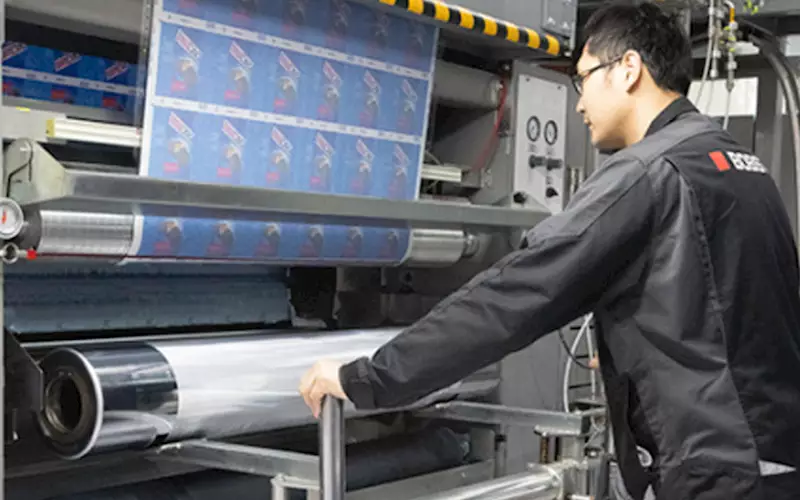How Bobst’s gravure presses found success in India and China
Innovation is driving the implementation of Bobst’s advanced gravure technology in emerging markets throughout India and South-east Asia, while, by responding to the specific requirements of these markets, the company has successfully established itself as a technology leader in the flexible packaging sector here.
02 Mar 2021 | By Rahul Kumar
Well-known for its superior quality and consistency across very long-runs, gravure printing remains the technology of choice for flexible packaging in Asia. Increasingly, packaging printers in China and India, as well as the rapidly growing newer economies of south-east Asia, are choosing to invest in more sophisticated gravure printing presses to meet market trends and customer demands.
Sustainable manufacturing, better service and predictable results are trends driving innovation in this field. Brand owners and regulatory bodies alike demand “greener” packaging, so converters are turning to manufacturers that offer state-of-the-art technology that can satisfy those requests.
India is embracing advanced technology
In India, converters are also looking to improve their green credentials by implementing best-in-class gravure printing technology. Here the Bobst Nova RS 5002 gravure press, which in 2019 evolved into the Nova RS 5003 model, has been incredibly well received.
Nilesh Pinto, business director India, business unit printing and converting, said, “The timing of the launch of the Nova RS 5002 was the most opportune for us. The market was looking for a high-speed press with automation features that would make life easier for the operator, one that could manage inks of varying quality and print using water-based inks. They also wanted great support and service.”
He added, “Our customers saw the true value proposition of this machine, and even though there were many cheaper options available, the Nova RS 5002 has been our biggest seller so far.”
The next-generation Nova RS 5003 press is more technologically advanced, guaranteeing process repeatability and high productivity. A host of energy-saving and waste reduction aspects offer cost-effective and sustainable production, automatic setting and registration ensure faster set-ups and changeovers, while the MPI inking system guarantees an excellent and consistent print quality. Amongst these are Registron register control and total automatic pre-register setting (TAPS), which now come as standard.
Through Bobst Connected services, printers can now work in real-time with Bobst remote experts to diagnose and resolve issues. On the Nova RS 5003, the new Sphere human machine interface (HMI) can track downtime and waste, along with programming of preventative maintenance. It can also save all the relevant data from each job, saving on job set up time and allowing to repeat rapidly when needed and this a vital part of the digital transformation taking place in the labels and packaging industry.
But it is not just in India that the Nova RS 5002 and 5003 have been successful. There are now over 160 machines sold worldwide as more printing companies align themselves with the Bobst new industry vision for future of packaging production, based on the four corner stones of connectivity, digitalisation, automation and sustainability.
“While these machines were born to respond to specific market requirements and suit emerging markets demands, they have gained ground and popularity to become an important reference machine globally with installations worldwide generating more and more interest,” said Jonathan Giubilato, product line director of gravure printing at Bobst Italia. “Despite the difficult working conditions during the Covid-19 pandemic, our customers are investing, and we are installing machines. The wheel keeps on turning as we have recently launched the Vision RS 5003 and there is still much more to come from Bobst, so watch this space!”
Changing the game in China
Bobst began to accelerate its involvement in China in 2018 with the establishment of a second production site, Bobst (Changzhou), complemented by a new Competence Center. Lubin Lu, business director of business unit printing and converting, Bobst (Changzhou), said, “When we first started to promote Bobst in 2012, very few customers in the flexible packaging industry in China knew the company, but today Bobst is well-known and has become synonymous with innovative technology and excellent quality.”
He added, “The decision to invest in Bobst Changzhou was a real turning point. Local manufacturing offers a better performance/price ratio, and local service and spare parts mean convenience and faster reaction times. The Competence Center is a unique selling point and it sets Bobst apart from local competitors.”
The RS 3.0 rotogravure press, which is manufactured by Bobst Changzhou specifically for the Chinese market, quickly became a very sought-after machine due to its advanced automation features, low emissions, and ability to print on a multitude of substrates, including new eco-friendly materials.
The latest model, the RS 3.0 Plus, features second-generation electronic shaft technology integrated with Registron register control, total automatic pe-register setting (TAPS) for fully automatic pre-register setting, highly efficient double-sided drying technology and Lower Explosion Limit (LEL) system to reduce emissions.
Building on the unrivalled quality of Bobst engineering and cost-efficient manufacturing experience of Bobst plants in China, the RS 3.0 Plus combines speed and quality with environmentally and operator-friendly production. Its ability to print with water-based inks was instrumental in earning Bobst Changzhou a certification as a demonstration and training base for alternative applications to VOCs in the packaging and printing industry from the Printing and Printing Equipment Industries Association of China (PEIAC).
Lubin Lu said, “The Bobst RS 3.0 Plus offers high-speed printing with water-based inks without compromising on quality, and this has proven to be a real game-changer in this market, because it solves the problem for printers and brand owners who need to meet new sustainability targets.”











 See All
See All